class: center, middle, inverse, title-slide # Data modelling and hypothesis tests ## MBP stats bootcamp ### Jason Lerch ### Day 2 --- <style> .small { font-size: 65%; } .medium { font-size: 80%; } .footnote { font-size: 75%; color: gray; } .smallcode { } .smallcode .remark-code { font-size: 50% } .smallercode { } .smallercode .remark-code { font-size: 75% } </style> # Hello World Goals for today: 1. The p value understood through permutations 1. Testing associations between two continuous variables 1. Testing associations between one factor and one continuous variable 1. The linear model 1. From factors to numbers (understanding contrasts) 1. Linear mixed effects models 1. Logistic regression --- # Reload the data ```r suppressMessages(library(tidyverse)) mice <- read_csv("mice.csv") %>% inner_join(read_csv("volumes.csv")) ``` ``` ## Parsed with column specification: ## cols( ## Age = col_double(), ## Sex = col_character(), ## Condition = col_character(), ## Mouse.Genotyping = col_character(), ## ID = col_double(), ## Timepoint = col_character(), ## Genotype = col_character(), ## DaysOfEE = col_double(), ## DaysOfEE0 = col_double() ## ) ``` ``` ## Parsed with column specification: ## cols( ## .default = col_double(), ## Timepoint = col_character() ## ) ``` ``` ## See spec(...) for full column specifications. ``` ``` ## Joining, by = c("ID", "Timepoint") ``` --- class: smallercode # Null hypothesis through simulations ```r baseline <- mice %>% filter(Timepoint == "Pre1") xtest <- with(baseline, chisq.test(Sex, Genotype)) simContingencyTable <- function() { out <- matrix(nrow=2, ncol=3) rownames(out) <- c("F", "M") colnames(out) <- c("CREB -/-", "CREB +/-", "CREB +/+") out[1,1] <- rbinom(1, 82, prob=xtest$expected[1,1] / 82) out[2,1] <- 82 - out[1,1] out[1,2] <- rbinom(1, 90, prob=xtest$expected[1,2] / 90) out[2,2] <- 90 - out[1,2] out[1,3] <- rbinom(1, 94, prob=xtest$expected[1,3] / 94) out[2,3] <- 94 - out[1,3] return(out) } simContingencyTable() %>% addmargins() ``` ``` ## CREB -/- CREB +/- CREB +/+ Sum ## F 37 31 43 111 ## M 45 59 51 155 ## Sum 82 90 94 266 ``` --- # Null hypothesis through simulations ```r nsims <- 1000 simulations <- data.frame(chisq = vector(length=nsims), p = vector(length=nsims)) for (i in 1:nsims) { tmp <- chisq.test(simContingencyTable()) simulations$chisq[i] <- tmp$statistic simulations$p[i] <- tmp$p.value } head(simulations) ``` ``` ## chisq p ## 1 1.50863090 0.4703325 ## 2 1.87408669 0.3917845 ## 3 0.27512162 0.8714814 ## 4 1.12534711 0.5696839 ## 5 1.63405289 0.4417433 ## 6 0.01524664 0.9924057 ``` --- # Null hypothesis through simulations ```r ggplot() + geom_histogram(data=simulations, aes(x=chisq, y=..density..), binwidth = 0.5) + geom_area(aes(c(0, 11)), stat="function", fun=function(x) dchisq(x, 2), xlim=c(0,8), fill="blue", alpha=0.5) + annotate("text", c(5,5), c(0.325, 0.3), colour=c("black", "blue"), label=c("Simulated", "dchisq")) + theme_minimal(16) ``` <!-- --> --- # Null hypothesis through simulations ```r xtest ``` ``` ## ## Pearson's Chi-squared test ## ## data: Sex and Genotype ## X-squared = 1.9838, df = 2, p-value = 0.3709 ``` ```r mean(simulations$chisq > xtest$statistic) ``` ``` ## [1] 0.403 ``` --- # Null hypothesis through simulations ```r ggplot() + geom_histogram(data=simulations, aes(p, ..density..), breaks=seq(0,1,length.out = 15)) + theme_minimal(16) ``` <!-- --> --- # Null hypothesis through permutations Basic idea: does the association between Genotype and Sex matter? If it does not, then switching it up should give similar answers. ```r permutation <- baseline %>% select(Genotype, Sex) %>% mutate(permuted1=sample(Sex), permuted2=sample(Sex), permuted3=sample(Sex)) permutation %>% sample_n(6) ``` ``` ## # A tibble: 6 x 5 ## Genotype Sex permuted1 permuted2 permuted3 ## <chr> <chr> <chr> <chr> <chr> ## 1 CREB +/- M F F M ## 2 CREB +/+ M M F M ## 3 CREB +/- M M M M ## 4 CREB +/- M M M M ## 5 CREB -/- M M F M ## 6 CREB +/+ M F M M ``` --- # Null hypothesis through permutations ```r addmargins(with(permutation, table(Genotype, Sex))) ``` ``` ## Sex ## Genotype F M Sum ## CREB -/- 29 53 82 ## CREB +/- 31 59 90 ## CREB +/+ 41 53 94 ## Sum 101 165 266 ``` ```r addmargins(with(permutation, table(Genotype, permuted1))) ``` ``` ## permuted1 ## Genotype F M Sum ## CREB -/- 29 53 82 ## CREB +/- 39 51 90 ## CREB +/+ 33 61 94 ## Sum 101 165 266 ``` ??? Margins stay the same --- # Null hypothesis through permutations ```r nsims <- 1000 permutations <- data.frame(chisq = vector(length=nsims), p = vector(length=nsims)) for (i in 1:nsims) { permuted <- baseline %>% mutate(permuted=sample(Sex)) tmp <- with(permuted, chisq.test(Genotype, permuted)) permutations$chisq[i] <- tmp$statistic permutations$p[i] <- tmp$statistic } mean(permutations$chisq > xtest$statistic) ``` ``` ## [1] 0.369 ``` ```r xtest ``` ``` ## ## Pearson's Chi-squared test ## ## data: Sex and Genotype ## X-squared = 1.9838, df = 2, p-value = 0.3709 ``` ??? Similar answer as parametric test --- # Simulations and permutations ```r data.frame(perms=permutations$chisq, sims =simulations$chisq) %>% gather(type, chisq) %>% ggplot() + aes(chisq, fill=type) + geom_histogram(position = position_dodge(), binwidth = 0.5) + theme_minimal(16) ``` <!-- --> ??? Similar answer as Monte Carlo Simulation --- # Review -- `\(\chi^2\)` test for two factors and contingency tables -- Null hypothesis as the nil hypothesis: no association -- p-value as the likelihood of a value equal to or more extreme occurring under the null hypothesis -- p-value and null hypothesis as _long run probability_: if the experiment were repeated again and again and again, how often would certain outcomes occur? -- Long run probability can be simulated by drawing random numbers/events from distributions under set assumptions. Sometimes called _Monte Carlo_ simulations or methods. -- Dependence/independence can also be tested using _permutation tests_: shuffling the data to build an empirical distribution. -- For our data, there was a sex bias, but it was equally biased across genotypes, and thus not a confound. --- # Testing factors and continuous values ```r baseline %>% select(Genotype, Sex, `bed nucleus of stria terminalis`, `hippocampus`) %>% gather(structure, volume, -Genotype, -Sex) %>% ggplot() + aes(Sex, volume) + geom_boxplot() + ylab(bquote(Volume ~ (mm^3))) + facet_wrap(~structure, scales = "free_y") + theme_gray(16) ``` <!-- --> --- # Aside: long vs wide data frames ```r twostructs <- baseline %>% mutate(bnst=`bed nucleus of stria terminalis`, hc=hippocampus) %>% select(Genotype, Sex, bnst, hc) ``` .pull-left[ ```r twostructs %>% head ``` ``` ## # A tibble: 6 x 4 ## Genotype Sex bnst hc ## <chr> <chr> <dbl> <dbl> ## 1 CREB +/- M 1.24 20.6 ## 2 CREB +/- M 1.31 20.7 ## 3 CREB +/- M 1.28 21.1 ## 4 CREB +/+ M 1.35 21.6 ## 5 CREB +/+ M 1.32 21.3 ## 6 CREB -/- M 1.19 19.6 ``` ] .pull-right[ ```r twostructs %>% gather(structure, volume, -Genotype, -Sex) %>% head ``` ``` ## # A tibble: 6 x 4 ## Genotype Sex structure volume ## <chr> <chr> <chr> <dbl> ## 1 CREB +/- M bnst 1.24 ## 2 CREB +/- M bnst 1.31 ## 3 CREB +/- M bnst 1.28 ## 4 CREB +/+ M bnst 1.35 ## 5 CREB +/+ M bnst 1.32 ## 6 CREB -/- M bnst 1.19 ``` ] --- # Means, variances, and standard deviations ```r twostructs %>% gather(structure, volume, -Genotype, -Sex) %>% group_by(structure, Sex) %>% summarise(mean=mean(volume), sd=sd(volume), var=var(volume), n=n()) ``` ``` ## # A tibble: 4 x 6 ## # Groups: structure [2] ## structure Sex mean sd var n ## <chr> <chr> <dbl> <dbl> <dbl> <int> ## 1 bnst F 1.21 0.0529 0.00280 101 ## 2 bnst M 1.27 0.0528 0.00279 165 ## 3 hc F 20.0 0.951 0.905 101 ## 4 hc M 20.2 0.872 0.760 165 ``` --- # Student's t test `$$t = \frac{\bar{X}_1 - \bar{X}_2}{S_{\bar{\Delta}}}$$` where `$$S_{\bar{\Delta}} = \sqrt{\frac{s^2_1}{n_1} + \frac{s^2_2}{n_2}}$$` where `\(s^2_i\)` is the sample variance and `\(\bar{X}_i\)` is the sample mean. --- # Student's t test `$$t = \frac{\bar{X}_1 - \bar{X}_2}{S_{\bar{\Delta}}}, S_{\bar{\Delta}} = \sqrt{\frac{s^2_1}{n_1} + \frac{s^2_2}{n_2}}$$` <table> <thead> <tr> <th style="text-align:left;"> structure </th> <th style="text-align:left;"> Sex </th> <th style="text-align:right;"> mean </th> <th style="text-align:right;"> sd </th> <th style="text-align:right;"> var </th> <th style="text-align:right;"> n </th> </tr> </thead> <tbody> <tr> <td style="text-align:left;"> bnst </td> <td style="text-align:left;"> F </td> <td style="text-align:right;"> 1.213525 </td> <td style="text-align:right;"> 0.0528958 </td> <td style="text-align:right;"> 0.0027980 </td> <td style="text-align:right;"> 101 </td> </tr> <tr> <td style="text-align:left;"> bnst </td> <td style="text-align:left;"> M </td> <td style="text-align:right;"> 1.270638 </td> <td style="text-align:right;"> 0.0527953 </td> <td style="text-align:right;"> 0.0027873 </td> <td style="text-align:right;"> 165 </td> </tr> </tbody> </table> ```r 1.213525 - 1.270638 ``` ``` ## [1] -0.057113 ``` ```r sqrt( (0.002797969/101) + (0.002787343/165) ) ``` ``` ## [1] 0.006677998 ``` ```r -0.057113/0.006677998 ``` ``` ## [1] -8.552413 ``` --- # Student's t test ```r t.test(bnst ~ Sex, twostructs) ``` ``` ## ## Welch Two Sample t-test ## ## data: bnst by Sex ## t = -8.5524, df = 211.25, p-value = 2.452e-15 ## alternative hypothesis: true difference in means is not equal to 0 ## 95 percent confidence interval: ## -0.07027706 -0.04394895 ## sample estimates: ## mean in group F mean in group M ## 1.213525 1.270638 ``` --- # df, degrees of freedom `$$df = \frac{(\frac{s^2_1}{n_1} + \frac{s^2_2}{n_2})}{\frac{(s^2_1/n_1)^2}{n_1 - 1}+\frac{(s^2_2/n_2)^2}{n_2-1}}$$` <!-- --> --- # df, degrees of freedom `$$\textrm{df} = \frac{(\frac{s^2_1}{n_1} + \frac{s^2_2}{n_2})}{\frac{(s^2_1/n_1)^2}{n_1 - 1}+\frac{(s^2_2/n_2)^2}{n_2-1}}$$` <!-- --> --- # Simpler version Assuming equal variance for the two groups: `$$t = \frac{\bar{X}_1 - \bar{X}_2}{S_p \cdot \sqrt{\frac{1}{n_1} + \frac{1}{n_2}}}, S_p = \sqrt{\frac{(n_1 - 1)s^2_{X_1} + (n_2 - 1)s^2_{X_2}}{n_1 + n_2 - 2}}, \textrm{df} = n_1 + n_2 - 2$$` ```r t.test(bnst ~ Sex, twostructs, var.equal=TRUE) ``` ``` ## ## Two Sample t-test ## ## data: bnst by Sex ## t = -8.5563, df = 264, p-value = 9.669e-16 ## alternative hypothesis: true difference in means is not equal to 0 ## 95 percent confidence interval: ## -0.07025588 -0.04397013 ## sample estimates: ## mean in group F mean in group M ## 1.213525 1.270638 ``` ??? In practice it rarely makes a difference - an equal variance will be assumed for linear models to be discussed later. --- # t test on BNST ```r t.test(bnst ~ Sex, twostructs) ``` ``` ## ## Welch Two Sample t-test ## ## data: bnst by Sex ## t = -8.5524, df = 211.25, p-value = 2.452e-15 ## alternative hypothesis: true difference in means is not equal to 0 ## 95 percent confidence interval: ## -0.07027706 -0.04394895 ## sample estimates: ## mean in group F mean in group M ## 1.213525 1.270638 ``` --- # t test on hippocampus ```r t.test(hc ~ Sex, twostructs) ``` ``` ## ## Welch Two Sample t-test ## ## data: hc by Sex ## t = -1.4813, df = 197.44, p-value = 0.1401 ## alternative hypothesis: true difference in means is not equal to 0 ## 95 percent confidence interval: ## -0.40226841 0.05716309 ## sample estimates: ## mean in group F mean in group M ## 20.02646 20.19901 ``` --- # t test: significance through simulations ```r simNullVolume <- function(sampleMean, sampleSD, n1, n2) { simData <- data.frame( volume = c( rnorm(n1, sampleMean, sampleSD), rnorm(n2, sampleMean, sampleSD) ), group = c( rep("G1", n1), rep("G2", n2) ) ) tt <- t.test(volume ~ group, simData) return(c(tt$statistic, tt$p.value)) } simNullVolume(20.02646, 0.9513596, 101, 165) ``` ``` ## t ## -0.7738973 0.4397644 ``` --- # An aside on the normal distribution <!-- --> --- # An aside on the normal distribution <!-- --> --- # An aside on the normal distribution <!-- --> --- # An aside on the normal distribution <!-- --> --- # Central limit theorem When independent random variables are added, they will eventually sum to a normal distribution -- Example: dice. Toss of one 6 sided die: ```r d1 <- floor(runif(1000, min=1, max=6+1)) qplot(d1, geom="histogram", breaks=1:6+0.5) + theme_minimal(16) ``` <!-- --> --- # Central limit theorem Add a second dice ```r d1 <- floor(runif(1000, min=1, max=6+1)) d2 <- floor(runif(1000, min=1, max=6+1)) qplot(d1+d2, geom="histogram", breaks=2:12+0.5) + theme_minimal(16) ``` <!-- --> --- # Central limit theorem And a third ```r d1 <- floor(runif(1000, min=1, max=6+1)) d2 <- floor(runif(1000, min=1, max=6+1)) d3 <- floor(runif(1000, min=1, max=6+1)) qplot(d1+d2+3, geom="histogram", breaks=3:18+0.5) + theme_minimal(16) ``` <!-- --> --- # t and normal distributions <!-- --> --- # t and normal distributions <!-- --> --- # t and normal distributions <!-- --> --- # t and normal distributions <!-- --> --- # Back to the simulation ```r simNullVolume <- function(sampleMean, sampleSD, n1, n2) { simData <- data.frame( volume = c( rnorm(n1, sampleMean, sampleSD), rnorm(n2, sampleMean, sampleSD) ), group = c( rep("G1", n1), rep("G2", n2) ) ) tt <- t.test(volume ~ group, simData) return(c(tt$statistic, tt$p.value)) } simNullVolume(20.02646, 0.9513596, 101, 165) ``` ``` ## t ## -0.8487625 0.3969366 ``` --- # Back to the simulation ```r nsims <- 1000 simulated <- data.frame( tstats=vector(length=nsims), pvals=vector(length=nsims)) for (i in 1:nsims) { sim <- simNullVolume(20.02646, 0.9513596, 101, 165) simulated$tstats[i] <- sim[1] simulated$pvals[i] <- sim[2] } qplot(simulated$tstat, geom="histogram", binwidth=0.3) + xlab("t") + theme_minimal(16) ``` <!-- --> --- # Back to the simulation ```r mean(simulated$tstats < -1.4813) ``` ``` ## [1] 0.067 ``` ```r t.test(hc ~ Sex, twostructs) ``` ``` ## ## Welch Two Sample t-test ## ## data: hc by Sex ## t = -1.4813, df = 197.44, p-value = 0.1401 ## alternative hypothesis: true difference in means is not equal to 0 ## 95 percent confidence interval: ## -0.40226841 0.05716309 ## sample estimates: ## mean in group F mean in group M ## 20.02646 20.19901 ``` --- # Two tails to the distribution ```r mean(simulated$tstats < -1.4813 | simulated$tstats > 1.4813) ``` ``` ## [1] 0.136 ``` ```r mean(abs(simulated$tstats) > 1.4813) ``` ``` ## [1] 0.136 ``` --- # p value through permutations ```r nsims <- 1000 permuted <- data.frame(tstat=vector(length=1000), pval=vector(length=1000)) for (i in 1:nsims) { tmp <- twostructs %>% mutate(pSex=sample(Sex)) %>% t.test(hc ~ pSex, .) permuted$tstat[i] <- tmp$statistic permuted$pval[i] <- tmp$p.value } mean(abs(permuted$tstat)>1.4813) ``` ``` ## [1] 0.14 ``` --- # Review _Central limit theorem_: most things we measure are made up of many additive components, and will likely be normally distributed. -- Vaguely normally distributed data can be described by its mean and standard deviation -- The t test assesses whether two groups differ in some (normally distributed) measure. -- The t distribution is like the normal distribution but with heavier tails; its shape is defined by its degrees of freedom. -- The null hypothesis is once again the nil hypothesis: the measure of interest comes from the same distribution in both groups. -- Parametric assumptions, monte carlo simulations, and permutations can all be used to obtain the p value. -- p value: how likely is this particular t statistic to occur if the measure is indeed derived from the same distribution in both groups. --- # Equal variance t-test revisited `$$t = \frac{\bar{X}_1 - \bar{X}_2}{S_p \cdot \sqrt{\frac{1}{n_1} + \frac{1}{n_2}}}, S_p = \sqrt{\frac{(n_1 - 1)s^2_{X_1} + (n_2 - 1)s^2_{X_2}}{n_1 + n_2 - 2}}, \textrm{df} = n_1 + n_2 - 2$$` ```r t.test(hc ~ Sex, twostructs, var.equal=TRUE) ``` ``` ## ## Two Sample t-test ## ## data: hc by Sex ## t = -1.5128, df = 264, p-value = 0.1315 ## alternative hypothesis: true difference in means is not equal to 0 ## 95 percent confidence interval: ## -0.39714399 0.05203867 ## sample estimates: ## mean in group F mean in group M ## 20.02646 20.19901 ``` --- # Let's rewrite the equal variance t-test ```r twostructs %>% mutate(sex2 = ifelse(Sex == "F", 1, 0), int = 1) %>% select(-bnst) %>% sample_n(8) ``` ``` ## # A tibble: 8 x 5 ## Genotype Sex hc sex2 int ## <chr> <chr> <dbl> <dbl> <dbl> ## 1 CREB +/+ M 20.2 0 1 ## 2 CREB +/- M 20.8 0 1 ## 3 CREB -/- M 19.5 0 1 ## 4 CREB -/- M 19.3 0 1 ## 5 CREB +/+ M 20.8 0 1 ## 6 CREB -/- F 18.6 1 1 ## 7 CREB +/+ M 20.9 0 1 ## 8 CREB +/- F 21.5 1 1 ``` --- # Still rewriting the t-test ```r X <- twostructs %>% mutate(Sex = ifelse(Sex == "F", 1, 0), Intercept = 1) %>% select(Intercept, Sex) %>% as.matrix y <- twostructs$hc solve(t(X)%*%X)%*%t(X)%*%y ``` ``` ## [,1] ## Intercept 20.1990127 ## Sex -0.1725527 ``` --- # Still rewriting the t-test ```r solve(t(X)%*%X)%*%t(X)%*%y ``` ``` ## [,1] ## Intercept 20.1990127 ## Sex -0.1725527 ``` ```r t.test(hc ~ Sex, twostructs, var.equal=TRUE) ``` ``` ## ## Two Sample t-test ## ## data: hc by Sex ## t = -1.5128, df = 264, p-value = 0.1315 ## alternative hypothesis: true difference in means is not equal to 0 ## 95 percent confidence interval: ## -0.39714399 0.05203867 ## sample estimates: ## mean in group F mean in group M ## 20.02646 20.19901 ``` --- # The linear model ```r X <- twostructs %>% mutate(Sex = ifelse(Sex == "F", 1, 0), Intercept = 1) %>% select(Intercept, Sex) %>% as.matrix y <- twostructs$hc solve(t(X)%*%X)%*%t(X)%*%y ``` ``` ## [,1] ## Intercept 20.1990127 ## Sex -0.1725527 ``` In matrix notation: `$$y = X\beta + \epsilon$$` -- Or, in algebraic notation: `$$y = \alpha + \beta X + \epsilon$$` ??? Allude to 0 and 1 as contrasts --- # Linear model terminology `$$y = \alpha + \beta X + \epsilon$$` |y|=|α|+|β|X|+|ε| |-|-|--------|-|-------|---|-|----------| |Response||Intercept||Slope|regressor||error| |dependent variable|||||independent variable|| |outcome|||||covariate|| -- ```r lm(hc ~ 1 + Sex, twostructs) ``` ``` ## ## Call: ## lm(formula = hc ~ 1 + Sex, data = twostructs) ## ## Coefficients: ## (Intercept) SexM ## 20.0265 0.1726 ``` --- # Linear model `$$y = \alpha + \beta X + \epsilon$$` `\(X\)` can be anything numeric, for example ```r lm(hippocampus ~ Age, baseline) ``` ``` ## ## Call: ## lm(formula = hippocampus ~ Age, data = baseline) ## ## Coefficients: ## (Intercept) Age ## 19.77402 0.05563 ``` ```r model.matrix(lm(hippocampus ~ Age, baseline)) %>% head ``` ``` ## (Intercept) Age ## 1 1 8.5 ## 2 1 8.5 ## 3 1 8.5 ## 4 1 9.5 ## 5 1 9.5 ## 6 1 8.5 ``` --- # Least squares Method of least squares: line can be fitted such that errors are minimized. One can determine α and β such that the sum of the squared distances between the data points and the line is minimized --- # Your turn <!-- --> --- # The answer ``` ## Warning: Removed 12 rows containing missing values (geom_smooth). ``` <!-- --> --- # Showing the error ``` ## Warning: Removed 12 rows containing missing values (geom_smooth). ``` <!-- --> --- # Least squares `$$\min_{\alpha,\beta} = \sum^n_{i=1}\epsilon^2_i = \min_{\alpha,\beta} = \sum^n_{i=1}(y_i - \alpha - \beta x_i)^2$$` --- # Understanding intercept and slope ```r ggplot(baseline) + aes(hippocampus, medulla) + geom_point() + geom_smooth(method="lm", se=F) ``` <!-- --> ```r lm(medulla ~ hippocampus, baseline) ``` ``` ## ## Call: ## lm(formula = medulla ~ hippocampus, data = baseline) ## ## Coefficients: ## (Intercept) hippocampus ## 17.3642 0.5433 ``` --- # Understanding intercept and slope ```r ggplot(baseline) + aes(hippocampus, medulla) + geom_point() + geom_smooth(method="lm", se=F, fullrange=T) + scale_x_continuous(limits = c(0, 23)) ``` <!-- --> ```r coef(lm(medulla ~ hippocampus, baseline)) ``` ``` ## (Intercept) hippocampus ## 17.3642275 0.5433333 ``` --- # Understanding intercept and slope, deux ```r baseline <- baseline %>% mutate(centredMedulla = medulla - mean(medulla)) ggplot(baseline) + aes(hippocampus, centredMedulla) + geom_point() + geom_smooth(method="lm", se=F, fullrange=T) + scale_x_continuous(limits = c(0, 23)) ``` <!-- --> ```r coef(lm(centredMedulla ~ hippocampus, baseline)) ``` ``` ## (Intercept) hippocampus ## -10.9391975 0.5433333 ``` --- # Understanding intercept and slope, trois ```r baseline <- baseline %>% mutate(centredHC = hippocampus - mean(hippocampus)) ggplot(baseline) + aes(centredHC, medulla) + geom_point() + geom_smooth(method="lm", se=F, fullrange=T) ``` <!-- --> ```r coef(lm(medulla ~ centredHC, baseline)) ``` ``` ## (Intercept) centredHC ## 28.3034250 0.5433333 ``` --- # Back to sex differences ```r ggplot(baseline) + aes(as.numeric(as.factor(Sex))-1, hippocampus) + geom_jitter(width = 0.01) + geom_smooth(method="lm", se=F, fullrange=T) ``` <!-- --> ```r coef(lm(hippocampus ~ Sex, baseline)) ``` ``` ## (Intercept) SexM ## 20.0264600 0.1725527 ``` --- # Linear model summary ```r summary(lm(hippocampus ~ Sex, baseline)) ``` ``` ## ## Call: ## lm(formula = hippocampus ~ Sex, data = baseline) ## ## Residuals: ## Min 1Q Median 3Q Max ## -3.5168 -0.5776 0.1747 0.6438 2.0251 ## ## Coefficients: ## Estimate Std. Error t value Pr(>|t|) ## (Intercept) 20.02646 0.08984 222.922 <2e-16 *** ## SexM 0.17255 0.11406 1.513 0.132 ## --- ## Signif. codes: 0 '***' 0.001 '**' 0.01 '*' 0.05 '.' 0.1 ' ' 1 ## ## Residual standard error: 0.9028 on 264 degrees of freedom ## Multiple R-squared: 0.008594, Adjusted R-squared: 0.004839 ## F-statistic: 2.288 on 1 and 264 DF, p-value: 0.1315 ``` --- # Factors with multiple levels ```r summary(lm(hippocampus ~ Genotype, baseline)) ``` ``` ## ## Call: ## lm(formula = hippocampus ~ Genotype, data = baseline) ## ## Residuals: ## Min 1Q Median 3Q Max ## -2.67542 -0.35859 0.04132 0.37381 1.81959 ## ## Coefficients: ## Estimate Std. Error t value Pr(>|t|) ## (Intercept) 19.18508 0.07121 269.40 <2e-16 *** ## GenotypeCREB +/- 1.29348 0.09845 13.14 <2e-16 *** ## GenotypeCREB +/+ 1.44536 0.09744 14.83 <2e-16 *** ## --- ## Signif. codes: 0 '***' 0.001 '**' 0.01 '*' 0.05 '.' 0.1 ' ' 1 ## ## Residual standard error: 0.6449 on 263 degrees of freedom ## Multiple R-squared: 0.4961, Adjusted R-squared: 0.4923 ## F-statistic: 129.5 on 2 and 263 DF, p-value: < 2.2e-16 ``` --- # Factors with multiple levels ```r baseline <- baseline %>% mutate(Genotype = factor(Genotype, levels=c("CREB +/+", "CREB +/-", "CREB -/-"))) summary(lm(hippocampus ~ Genotype, baseline)) ``` ``` ## ## Call: ## lm(formula = hippocampus ~ Genotype, data = baseline) ## ## Residuals: ## Min 1Q Median 3Q Max ## -2.67542 -0.35859 0.04132 0.37381 1.81959 ## ## Coefficients: ## Estimate Std. Error t value Pr(>|t|) ## (Intercept) 20.63044 0.06651 310.172 <2e-16 *** ## GenotypeCREB +/- -0.15188 0.09510 -1.597 0.111 ## GenotypeCREB -/- -1.44536 0.09744 -14.833 <2e-16 *** ## --- ## Signif. codes: 0 '***' 0.001 '**' 0.01 '*' 0.05 '.' 0.1 ' ' 1 ## ## Residual standard error: 0.6449 on 263 degrees of freedom ## Multiple R-squared: 0.4961, Adjusted R-squared: 0.4923 ## F-statistic: 129.5 on 2 and 263 DF, p-value: < 2.2e-16 ``` --- # Factors with multiple levels ```r ggplot(baseline) + aes(Genotype, hippocampus) + geom_boxplot() ``` 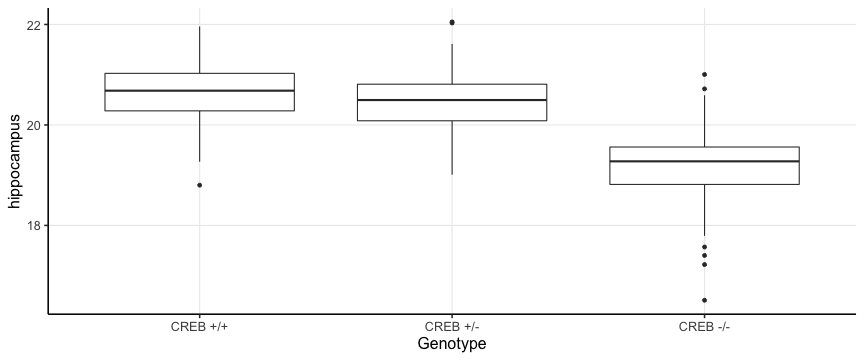<!-- --> --- # Factors with multiple levels ```r model.matrix(lm(hippocampus ~ Genotype, baseline)) %>% as.data.frame() %>% mutate(Genotype=baseline$Genotype) %>% head(8) ``` ``` ## (Intercept) GenotypeCREB +/- GenotypeCREB -/- Genotype ## 1 1 1 0 CREB +/- ## 2 1 1 0 CREB +/- ## 3 1 1 0 CREB +/- ## 4 1 0 0 CREB +/+ ## 5 1 0 0 CREB +/+ ## 6 1 0 1 CREB -/- ## 7 1 1 0 CREB +/- ## 8 1 0 1 CREB -/- ``` --- # Additive terms ```r summary(lm(hippocampus ~ Sex + Genotype, baseline)) ``` ``` ## ## Call: ## lm(formula = hippocampus ~ Sex + Genotype, data = baseline) ## ## Residuals: ## Min 1Q Median 3Q Max ## -2.52597 -0.36182 0.01817 0.41871 1.73782 ## ## Coefficients: ## Estimate Std. Error t value Pr(>|t|) ## (Intercept) 20.50007 0.07984 256.751 < 2e-16 *** ## SexM 0.23123 0.08068 2.866 0.00449 ** ## GenotypeCREB +/- -0.17309 0.09412 -1.839 0.06703 . ## GenotypeCREB -/- -1.46444 0.09636 -15.197 < 2e-16 *** ## --- ## Signif. codes: 0 '***' 0.001 '**' 0.01 '*' 0.05 '.' 0.1 ' ' 1 ## ## Residual standard error: 0.6362 on 262 degrees of freedom ## Multiple R-squared: 0.5114, Adjusted R-squared: 0.5059 ## F-statistic: 91.43 on 3 and 262 DF, p-value: < 2.2e-16 ``` ??? What happened? Both sex and the hets became more significant? --- # Additive terms ```r ggplot(baseline) + aes(Genotype, hippocampus, colour=Sex) + geom_boxplot() ``` 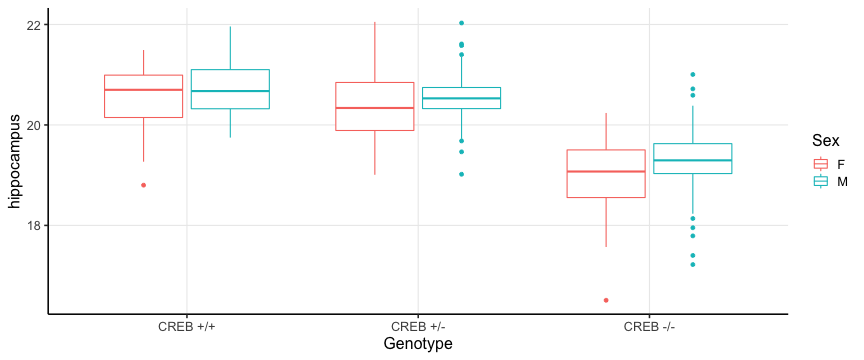<!-- --> --- # Additive terms ```r model.matrix(lm(hippocampus ~ Sex + Genotype, baseline)) %>% as.data.frame() %>% mutate(Genotype=baseline$Genotype, Sex=baseline$Sex) %>% sample_n(8) ``` ``` ## (Intercept) SexM GenotypeCREB +/- GenotypeCREB -/- Genotype Sex ## 1 1 1 0 0 CREB +/+ M ## 2 1 1 1 0 CREB +/- M ## 3 1 1 0 0 CREB +/+ M ## 4 1 0 0 1 CREB -/- F ## 5 1 1 0 0 CREB +/+ M ## 6 1 1 0 1 CREB -/- M ## 7 1 1 0 1 CREB -/- M ## 8 1 0 0 1 CREB -/- F ``` --- # Residuals ```r l <- lm(hippocampus ~ Sex, baseline) qplot(residuals(l)) ``` ``` ## `stat_bin()` using `bins = 30`. Pick better value with `binwidth`. ``` <!-- --> --- # Residuals ```r l <- lm(hippocampus ~ Genotype, baseline) qplot(residuals(l)) ``` ``` ## `stat_bin()` using `bins = 30`. Pick better value with `binwidth`. ``` 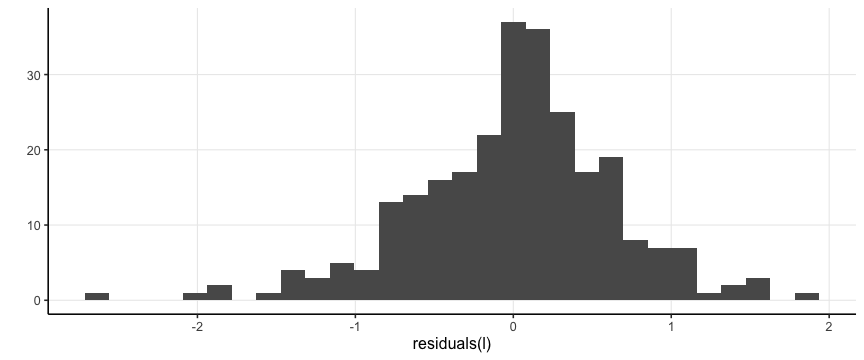<!-- --> --- # Residuals ```r baseline <- baseline %>% mutate(HCGenotypeResids = residuals(lm(hippocampus ~ Genotype))) p1 <- ggplot(baseline) + aes(Sex, hippocampus) + geom_boxplot() p2 <- ggplot(baseline) + aes(Sex, HCGenotypeResids) + geom_boxplot() cowplot::plot_grid(p1, p2) ``` 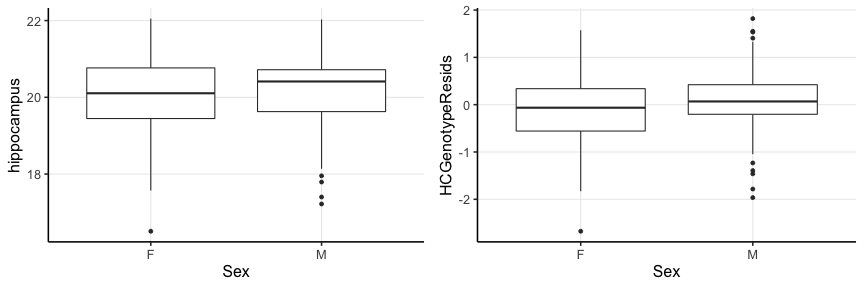<!-- --> --- class: smallercode # ANOVA ```r anova(lm(hippocampus ~ Sex + Genotype, baseline)) ``` ``` ## Analysis of Variance Table ## ## Response: hippocampus ## Df Sum Sq Mean Sq F value Pr(>F) ## Sex 1 1.865 1.865 4.6087 0.03273 * ## Genotype 2 109.148 54.574 134.8338 < 2e-16 *** ## Residuals 262 106.044 0.405 ## --- ## Signif. codes: 0 '***' 0.001 '**' 0.01 '*' 0.05 '.' 0.1 ' ' 1 ``` -- ```r anova(lm(hippocampus ~ Genotype + Sex, baseline)) ``` ``` ## Analysis of Variance Table ## ## Response: hippocampus ## Df Sum Sq Mean Sq F value Pr(>F) ## Genotype 2 107.688 53.844 133.0310 < 2.2e-16 *** ## Sex 1 3.325 3.325 8.2145 0.004493 ** ## Residuals 262 106.044 0.405 ## --- ## Signif. codes: 0 '***' 0.001 '**' 0.01 '*' 0.05 '.' 0.1 ' ' 1 ``` --- # ANOVA   --- # ANOVA vs linear model * closely related * sequential removal of variance - so order of terms matters for ANOVA, not lm * ANOVA describes amount of variance explained by each term * no concept of reference level * if there are multiple levels to a factor, it explains how _all_ levels contribute to variance. * ANOVA is about variance - no information about direction or size of effect --- class: smallcode # ANOVA vs linear model ```r anova(lm(hippocampus ~ Genotype + Sex, baseline)) ``` ``` ## Analysis of Variance Table ## ## Response: hippocampus ## Df Sum Sq Mean Sq F value Pr(>F) ## Genotype 2 107.688 53.844 133.0310 < 2.2e-16 *** ## Sex 1 3.325 3.325 8.2145 0.004493 ** ## Residuals 262 106.044 0.405 ## --- ## Signif. codes: 0 '***' 0.001 '**' 0.01 '*' 0.05 '.' 0.1 ' ' 1 ``` ```r summary(lm(hippocampus ~ Genotype + Sex, baseline)) ``` ``` ## ## Call: ## lm(formula = hippocampus ~ Genotype + Sex, data = baseline) ## ## Residuals: ## Min 1Q Median 3Q Max ## -2.52597 -0.36182 0.01817 0.41871 1.73782 ## ## Coefficients: ## Estimate Std. Error t value Pr(>|t|) ## (Intercept) 20.50007 0.07984 256.751 < 2e-16 *** ## GenotypeCREB +/- -0.17309 0.09412 -1.839 0.06703 . ## GenotypeCREB -/- -1.46444 0.09636 -15.197 < 2e-16 *** ## SexM 0.23123 0.08068 2.866 0.00449 ** ## --- ## Signif. codes: 0 '***' 0.001 '**' 0.01 '*' 0.05 '.' 0.1 ' ' 1 ## ## Residual standard error: 0.6362 on 262 degrees of freedom ## Multiple R-squared: 0.5114, Adjusted R-squared: 0.5059 ## F-statistic: 91.43 on 3 and 262 DF, p-value: < 2.2e-16 ``` --- class: smallercode # `\(R^2\)`   --- class: smallercode <img src="images/r2.png" width="50%"> ```r summary(lm(hippocampus ~ Genotype + Sex, baseline)) ``` ``` ## ## Call: ## lm(formula = hippocampus ~ Genotype + Sex, data = baseline) ## ## Residuals: ## Min 1Q Median 3Q Max ## -2.52597 -0.36182 0.01817 0.41871 1.73782 ## ## Coefficients: ## Estimate Std. Error t value Pr(>|t|) ## (Intercept) 20.50007 0.07984 256.751 < 2e-16 *** ## GenotypeCREB +/- -0.17309 0.09412 -1.839 0.06703 . ## GenotypeCREB -/- -1.46444 0.09636 -15.197 < 2e-16 *** ## SexM 0.23123 0.08068 2.866 0.00449 ** ## --- ## Signif. codes: 0 '***' 0.001 '**' 0.01 '*' 0.05 '.' 0.1 ' ' 1 ## ## Residual standard error: 0.6362 on 262 degrees of freedom ## Multiple R-squared: 0.5114, Adjusted R-squared: 0.5059 ## F-statistic: 91.43 on 3 and 262 DF, p-value: < 2.2e-16 ``` --- class: smallercode # Interactions ```r summary(lm(hippocampus ~ Condition*DaysOfEE, mice)) ``` ``` ## ## Call: ## lm(formula = hippocampus ~ Condition * DaysOfEE, data = mice) ## ## Residuals: ## Min 1Q Median 3Q Max ## -3.4182 -0.5314 0.1366 0.6149 2.9409 ## ## Coefficients: ## Estimate Std. Error t value Pr(>|t|) ## (Intercept) 20.438740 0.047152 433.468 < 2e-16 *** ## ConditionExercise -0.250796 0.076893 -3.262 0.001135 ** ## ConditionIsolated Standard -0.427943 0.084086 -5.089 4.09e-07 *** ## ConditionStandard -0.183349 0.066496 -2.757 0.005904 ** ## DaysOfEE 0.050438 0.005760 8.756 < 2e-16 *** ## ConditionExercise:DaysOfEE -0.013878 0.009182 -1.511 0.130912 ## ConditionIsolated Standard:DaysOfEE -0.029703 0.010064 -2.952 0.003215 ** ## ConditionStandard:DaysOfEE -0.030560 0.008084 -3.780 0.000163 *** ## --- ## Signif. codes: 0 '***' 0.001 '**' 0.01 '*' 0.05 '.' 0.1 ' ' 1 ## ## Residual standard error: 0.8901 on 1384 degrees of freedom ## Multiple R-squared: 0.1149, Adjusted R-squared: 0.1105 ## F-statistic: 25.68 on 7 and 1384 DF, p-value: < 2.2e-16 ``` --- class: smallercode # Interactions ```r mice <- mice %>% mutate(Condition=factor(Condition, levels= c("Standard", "Isolated Standard", "Exercise", "Enriched"))) summary(lm(hippocampus ~ Condition*DaysOfEE, mice)) ``` ``` ## ## Call: ## lm(formula = hippocampus ~ Condition * DaysOfEE, data = mice) ## ## Residuals: ## Min 1Q Median 3Q Max ## -3.4182 -0.5314 0.1366 0.6149 2.9409 ## ## Coefficients: ## Estimate Std. Error t value Pr(>|t|) ## (Intercept) 20.2553911 0.0468869 432.005 < 2e-16 *** ## ConditionIsolated Standard -0.2445938 0.0839380 -2.914 0.003626 ** ## ConditionExercise -0.0674464 0.0767310 -0.879 0.379554 ## ConditionEnriched 0.1833493 0.0664956 2.757 0.005904 ** ## DaysOfEE 0.0198788 0.0056713 3.505 0.000471 *** ## ConditionIsolated Standard:DaysOfEE 0.0008565 0.0100130 0.086 0.931848 ## ConditionExercise:DaysOfEE 0.0166812 0.0091268 1.828 0.067807 . ## ConditionEnriched:DaysOfEE 0.0305596 0.0080836 3.780 0.000163 *** ## --- ## Signif. codes: 0 '***' 0.001 '**' 0.01 '*' 0.05 '.' 0.1 ' ' 1 ## ## Residual standard error: 0.8901 on 1384 degrees of freedom ## Multiple R-squared: 0.1149, Adjusted R-squared: 0.1105 ## F-statistic: 25.68 on 7 and 1384 DF, p-value: < 2.2e-16 ``` --- class: smallcode # Interacations ```r l1 <- lm(hippocampus ~ DaysOfEE + Condition, mice) l2 <- lm(hippocampus ~ DaysOfEE * Condition, mice) mice <- mice %>% mutate(fittedl1 = fitted(l1), fittedl2 = fitted(l2)) ``` .pull-left[ ```r ggplot(mice) + aes(x=DaysOfEE, y=hippocampus, colour=Condition) + geom_point() + geom_smooth(aes(y=fittedl1), method="lm", se=F) + theme(legend.position = "none") ``` 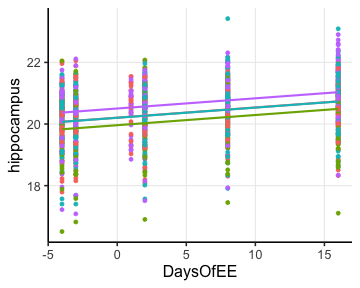<!-- --> ] .pull-right[ ```r ggplot(mice) + aes(x=DaysOfEE, y=hippocampus, colour=Condition) + geom_point() + geom_smooth(aes(y=fittedl2), method="lm", se=F) + theme(legend.position = "none") ``` 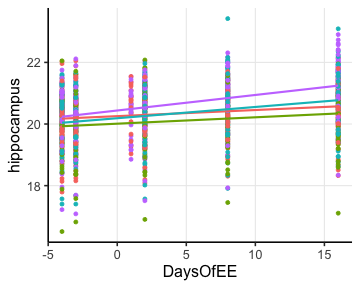<!-- --> ] --- # Linear model assumptions * the model is linear in parameters * can still fit curves via polynomials, but no non-linear models -- * mean residual is zero -- * homoscedasticity - residuals have equal variance -- * residuals are normally distributed -- * no autocorrelation of residuals -- * number of observations must be greater than ncol(X) -- * no perfect multicollinearity --- # Linear model assumptions ```r l1 <- lm(hippocampus ~ Condition*DaysOfEE, mice) qplot(fitted(l1), residuals(l1)) ``` 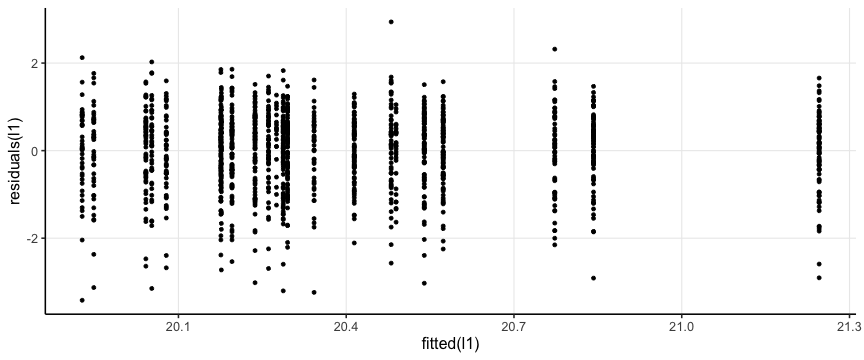<!-- --> --- # Mixed effects models a model containing both _fixed_ and _random_ effects. Can model autocorrelation of variables `$$y = X \beta + Z \mu + \epsilon$$` where `\(y\)` is the vector of observations `\(\beta\)` is an unknown vector of fixed effects `\(\mu\)` is an unknown vector of random effects, with `\(E(\mu) = 0\)` and `\(textrm(var)(\mu) = G\)` `\(\epsilon\)` is an unknown vector of random errors, with mean of 0 ( `\(E(\epsilon) = 0\)` ) `\(X\)` and `\(Z\)` are the design matrices --- # Linear mixed effects model R implementation in lme4 package ``` library(lme4) summary(lmer(hippocampus ~ Condition*DaysOfEE + (1|ID), mice)) ``` --- class: smallcode # Linear mixed effects model ```r library(lme4) ``` ``` ## Loading required package: Matrix ``` ``` ## ## Attaching package: 'Matrix' ``` ``` ## The following object is masked from 'package:tidyr': ## ## expand ``` ```r summary(lmer(hippocampus ~ Condition*DaysOfEE + (1|ID), mice)) ``` ``` ## Linear mixed model fit by REML ['lmerMod'] ## Formula: hippocampus ~ Condition * DaysOfEE + (1 | ID) ## Data: mice ## ## REML criterion at convergence: 1787.7 ## ## Scaled residuals: ## Min 1Q Median 3Q Max ## -6.8471 -0.4622 -0.0220 0.4511 4.8770 ## ## Random effects: ## Groups Name Variance Std.Dev. ## ID (Intercept) 0.70263 0.8382 ## Residual 0.09907 0.3148 ## Number of obs: 1392, groups: ID, 283 ## ## Fixed effects: ## Estimate Std. Error t value ## (Intercept) 20.2392665 0.0894412 226.286 ## ConditionIsolated Standard -0.2197913 0.1579606 -1.391 ## ConditionExercise -0.0748979 0.1427582 -0.525 ## ConditionEnriched 0.1965268 0.1268424 1.549 ## DaysOfEE 0.0210152 0.0020142 10.434 ## ConditionIsolated Standard:DaysOfEE -0.0009449 0.0035515 -0.266 ## ConditionExercise:DaysOfEE 0.0172442 0.0032441 5.316 ## ConditionEnriched:DaysOfEE 0.0294353 0.0028724 10.248 ## ## Correlation of Fixed Effects: ## (Intr) CndtIS CndtnEx CndtnEn DysOEE CIS:DO CndtnEx:DOEE ## CndtnIsltdS -0.566 ## CondtnExrcs -0.627 0.355 ## CndtnEnrchd -0.705 0.399 0.442 ## DaysOfEE -0.085 0.048 0.053 0.060 ## CndtIS:DOEE 0.048 -0.088 -0.030 -0.034 -0.567 ## CndtnEx:DOEE 0.053 -0.030 -0.091 -0.037 -0.621 0.352 ## CndtnEn:DOEE 0.060 -0.034 -0.037 -0.085 -0.701 0.398 0.435 ``` --- # Linear mixed effects model ```r l2 <- lmer(hippocampus ~ Condition*DaysOfEE + (1|ID), mice) qplot(fitted(l2), residuals(l2)) ``` 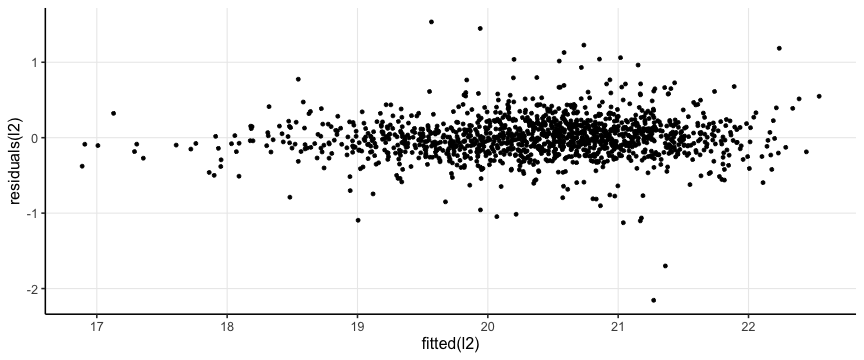<!-- --> --- # Linear mixed effects model ```r anova(lmer(hippocampus ~ Condition*DaysOfEE + (1|ID), mice)) ``` ``` ## Analysis of Variance Table ## Df Sum Sq Mean Sq F value ## Condition 3 1.277 0.426 4.2962 ## DaysOfEE 1 84.970 84.970 857.6805 ## Condition:DaysOfEE 3 13.026 4.342 43.8296 ``` --- # Review -- Linear models are the key tool in statistical modelling -- Additive terms let you infer on multiple covariates while controlling for the rest -- ANOVAs and linear models are two sides of the same coin -- Mixed effects models allow for correlated errors - especially longitudinal data -- generalized linear models available for non gaussian response variables: logistic, poisson, etc. --- # Null Hypothesis Significance Testing -- 1. Define the distributional assumptions for the random variable of interest -- 1. Formulate the null hypothesis -- 1. Fix a significance value -- 1. Construct a test statistic -- 1. Construct a critical region for the test statistic where H0 is rejected -- 1. Calculate test statistic based on sample values -- 1. If test result is in rejection region, H0 is rejected, H1 is statistically significant -- 1. If test result is not in rejection region, H0 is not rejected and therefore accepted. --- # Types of Errors  --- # Confidence Intervals  Compute mean of sample Compute sd of sample CI = mean ± qt*(sd/sqrt(n)) where qt = 1 for 0.68 interval, 2 for 0.95 interval --- # Confidence Intervals 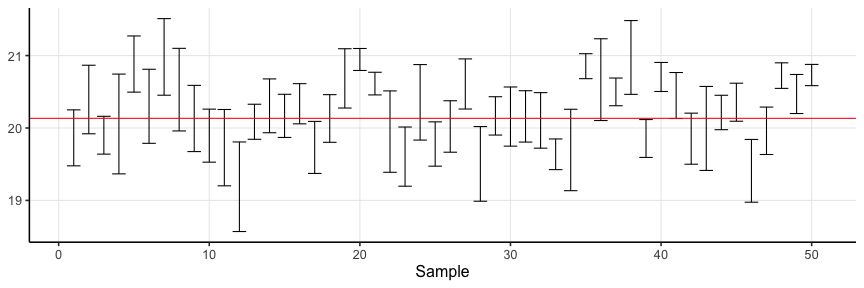<!-- -->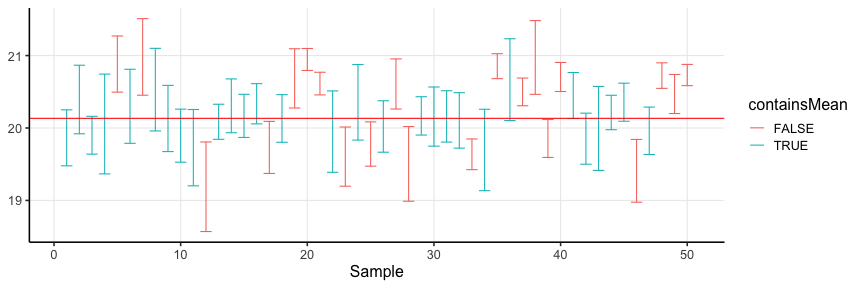<!-- --> --- class: inverse, center, middle # Logistic regression (Over to Mehran) --- ## Data and packages for these slides: ```r knitr::opts_chunk$set(echo = FALSE) # required_packages = c("caret", "tree", "randomForest", # "cowplot", "e1071", "PRROC") # install.packages(required_packages) require(tidyverse) require(cowplot) mice_df = read_csv("mice.csv") volume_df = read_csv("volumes.csv") mice = inner_join(mice_df, volume_df) ``` --- # Generalized linear models * The linear models assumes that the errors of the dependent variable are normally distributed * Can you think of any examples in biology or physics that this doesn't happen? -- * The number of cells you count at different time points after treatment with a new drug * How are the count data distributed? -- * The number of sequencing reads mapped to a gene at different time points -- * Binary outcome: Does increase in alcohol consumption affect cancer occurence? -- * Approach: * Model the dependent variable according to a particular distribution -- * Model the parameters of this distribution according to a link function --- ## Binary variables in mice dataset Does the striatal volume correlate with haveing an amygdala larger than 10 `\(mm^3\)`? ```r mice$amygdala.group = ifelse(mice$amygdala > 10, 1, 0) ggplot(mice, aes(x=amygdala.group, y=striatum, group=amygdala.group)) + geom_boxplot() + theme_bw(base_size=18) ``` 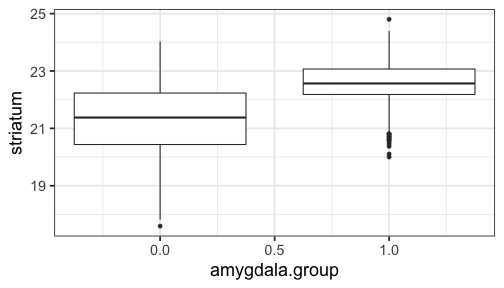<!-- --> --- ## Linear model for binary variables? * If the independent variable is binary, can we fit the linear model? ```r ggplot(mice, aes(x=striatum, y=amygdala.group)) + geom_point() + xlab("Volume of striatum") + ylab("Amygdala group") + geom_smooth(method="lm") + ggtitle("Amygdala group ~ Striatum volume") ``` 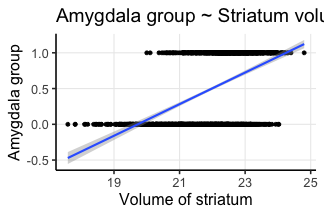<!-- --> --- ## Why we can't use linear model for classification? * Suppose we want to predict seizure, stroke, or overdose given some measurements from patients -- * If we model them as 1, 2, and 3 respectively, we are assuming order -- * Even in case of binary variables, our estimates may exceed range of [0, 1], making the interpretation unnecessarily hard -- * Any other reasons that contradict assumptions of the linear model? -- * Read this [blogpost](http://thestatsgeek.com/2015/01/17/why-shouldnt-i-use-linear-regression-if-my-outcome-is-binary), it might be a question on your quiz or final exam. --- ## Logistic function * `\(\frac{L}{1 + e^{-k\times (x - \sigma_0)}}\)` ```r logistic_function = function(input, curve_max=1, curve_steepness=1, sig_mid=0){ output = curve_max / (1 + exp(-curve_steepness * (input - sig_mid))) } input_vals = rnorm(50, sd=3) out_df = data.frame( X=input_vals, Y=logistic_function(input_vals)) ggplot(out_df, aes(x=X, y=Y)) + geom_line() ``` 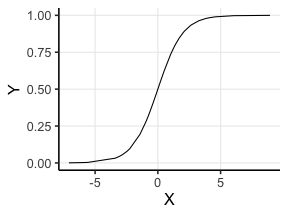<!-- --> --- ## Linear model for binary variables? 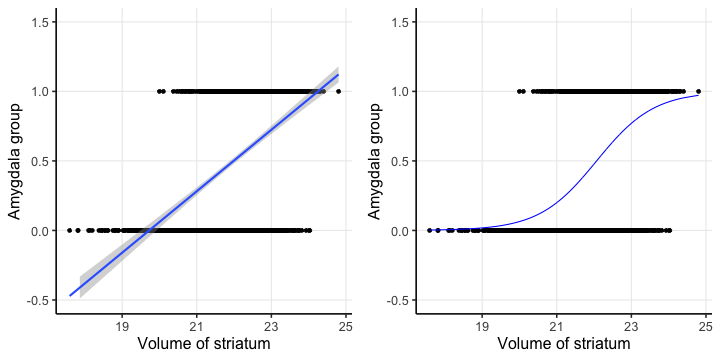<!-- --> --- ## Logistic regression as a generalized linear model * How do we model the dependent variable which has two categories? -- * What is the probability of two tails in 6 coin flips? -- * `\(\dbinom 62 \times 0.5^4 \times (1-0.5)^2\)` -- * `\(\frac{6!}{2! \times (6-2)!} \times 0.5^6 = \frac{15}{64}\)` -- * Binomial distribution models number of occurences of a binary event in a certain number of trials -- * Binomial distribution assumes each observation in the trial is independent -- * In logistic regression, we model the outcome according to the binomial distribution -- * We also model the parameters of the binomial distributions using log odds (aka logit) link function --- ## Solving the logistic model * `\(Y = \beta_0\)` + `\(\beta X\)` -- * `\(p = p(Y=1)\)` -- * `\(p = \frac{1}{1 + e^{\beta_0 + \beta X}} \rightarrow\)` estimating probability with logistic function -- * `\(\frac{p}{1 - p} = e^{\beta_0 + \beta X} \rightarrow\)` odds -- * `\(\text{ln}(\frac{p}{1 - p}) = \beta_0 + \beta X \rightarrow\)` logit or log of odds -- * In linear model, `\(\beta\)` shows how a unit increase in *X* changes *Y* -- * The effect size `\(\beta\)` shows how a unit increase in *X* changes log odds -- * In linear regression, we used least squared to minimize mean squared error -- * In logistic regression, we aim to maximize the __likelihood__ function -- * Read the pseudocode for logistic regression [here](https://ml-cheatsheet.readthedocs.io/en/latest/logistic_regression.html) --- # The likelihood function * If index `\(i\)` refers to samples that `\(y = 1\)`, and index `\(i^\prime\)` refers to sample of class `\(y = 0\)` -- * We want to estimate parameters `\(\beta\)` and `\(\beta_0\)` so that the multiplication of the output of logistic function for samples `\(i\)` by 1 minus the output of logistic function for samples `\(i^\prime\)` is the largest possible value -- * `\(l(\beta_0, \beta) = \underset{i:y_i=1}{\Pi} p(x_i) \underset{i^\prime:y_{i^\prime}=0}{\Pi} (1 - p(x_{i^\prime})) \rightarrow\)` Likelihood function -- * Algorithms such as the expectation maximization algorithm, can initialize these parameters by some values and change the values iteratively to obtain the maximum value for the likelihood function --- # Group assignment #2 .medium[ Start with yesterday's assignment, and add 1. A statistical test of the difference in hippocampal volume by Genotype at the final timepoint. 1. A statistical test of the difference in hippocampal volume by Condition at the final timepoint. 1. A statistical test of the difference in hippocampal volume by Condition and Genotype at the final timepoint. 1. Compute a permutation test of hippocampal volume by Condition and Genotype test, compare p value(s) to what you obtained from the parametric test. 1. A statistical test of the change over time by Condition and Genotype. Make sure to write a description of how to interpret the estimates of each of the terms. 1. Integrate your statistics and visualization (adding new ones or removing old ones where need be) to make your document a cohesive report. 1. Write a summary paragraph interpreting your outcomes. 1. Make sure that all team members are listed as authors. 1. Any questions: ask here in person, or email us (jason.lerch@ndcn.ox.ac.uk, mehran.karimzadehreghbati@mail.utoronto.ca) and we promise to answer quickly. ]